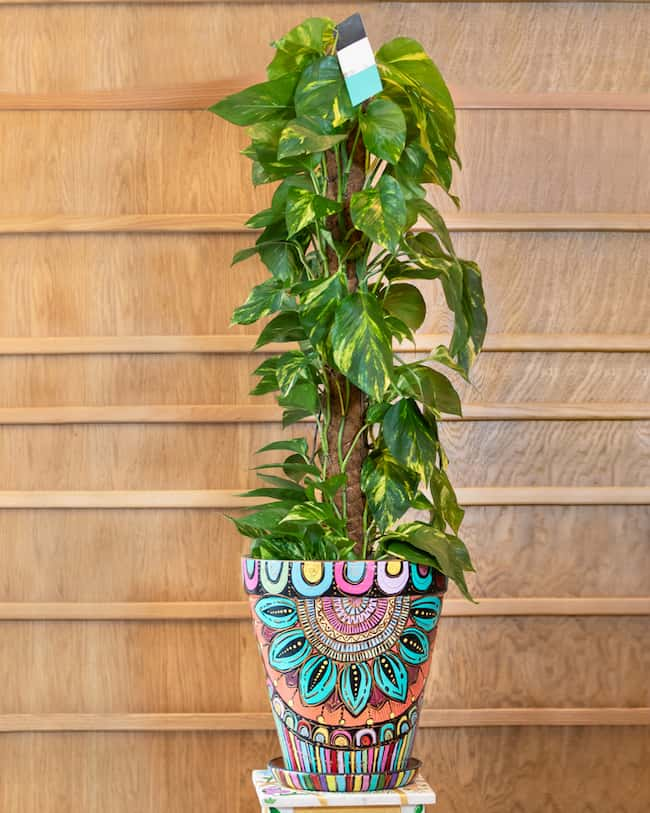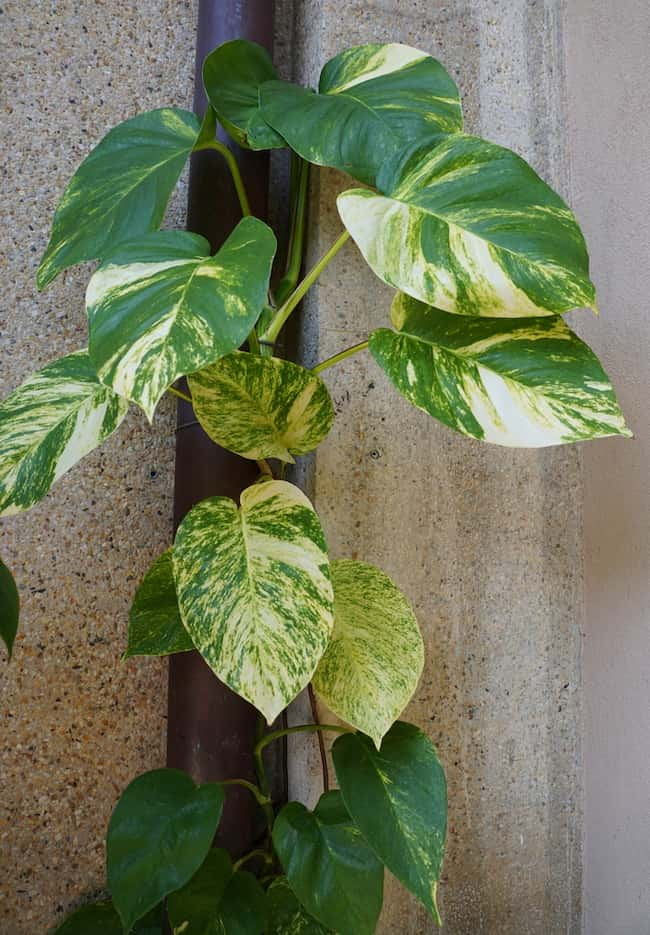For a long time, I was always a bit afraid of dealing with a climbing plant. Trailing vines or indoor trees seemed easy compared to having to actually help a plant on its way. But one day, after seeing far too many gorgeous Pinterest photos on what I could be doing, I decided to bite the bullet and get a climbing pothos. And I should have done it years earlier given how easy it ended up being!
So if you’re wondering how to train pothos to climb, it’s simple. Just find a support to tie the plant to and keep trimming the vines as they grow. Within a few weeks, your pothos will be climbing up its new home and sprouting new beautiful leaves along the way.
If you want to learn how to transform a common household plant into a beautiful cascading vine, read on for my step-by-step guide. You’ll know how to train indoor climbing plants in no time!

Table of Contents
How to train pothos to climb
It’s pretty easy to train an indoor plant to climb. Pothos plants in particular are great indoor climbers because they don’t require direct sun and can survive in a wide range of temperatures. Since they’re low maintenance, this makes them ideal for those who don’t have a lot of time to take care of their plants.
Here’s how you can train a pothos to climb in your home:
- Make sure the light and temperature conditions are right. First, it’s important to know the light a pothos plant needs in order to thrive. Pothos plants need medium bright, indirect light, moderate humidity and temperatures somewhere around 70-75 degrees F. Make sure you climb your pathos in an area with these conditions.
- Choose the right soil for your climbing pothos. You can take a look at our pick for the best pothos soil mix here but, basically, they can be potted in an all-purpose potting mix, as long as it drains well.
- Put it in the right pot. Not only is it important to pick a pot that’s big enough, but be sure to also choose a pot that has drainage holes in the bottom. This is because your pothos plant needs drainage and space to thrive.
- Get your equipment ready: Now that you know the basics, you’re ready to get started. Here’s what you’ll need to train pothos on a wall or other support structure:
- A pothos plant
- Support to tie the plant to (I used a trellis, but you could also use wire, picture hangers, bamboo canes, command hooks, or string. Choose one that will blend in with your plant and décor and support the weight of your plant, depending on its size.)
- Scissors
- String for your support (if needed)
- Add the support to your potted plant. If you’re using a stake, put it in the pot in an area where it isn’t very visible but the stalks of the plant can reach it. For a trellis, place the trellis against the wall or in the pot so that it’s stable. For wire supports, use picture hangers or command hooks to attach them to the wall. You could also use bamboo canes or string to create a lattice for your pothos plant to climb.
- Start tying your pothos’ vines. Once you have your support in place, start training pothos to climb by gently tying the vines to the support with string. Gently twist the vine so that it is securely wrapped. You can also use plant ties, which are available at most garden stores.
- Prune as needed. If your pothos plant is too large to tie to the support by itself, you can trim some of the vines so that they’re shorter and easier to handle. Just be sure not to cut off too many of the vines when pruning your pothos plant, as they will be needed to help the plant climb.
- Keep your pothos fed. Your pothos plant will appreciate fertilizer 2 to 4 times a year, particularly during its growing season/
- Continue to maintain your climbing pothos. As your pothos plant grows, continue to tie it to the support and trim the vines as needed. You can also add additional supports as needed. In a few weeks, you’ll have a beautiful pothos vine climbing up your wall or trellis. Enjoy!

How long does it take for pothos to climb?
If you start your plant as a cutting, it will take a year or two in order to have enough growth to start training your climbing pothos. When taking a cutting, you should make sure there is a root node and a couple of leaves. This will ensure that your plant will have a good chance of surviving.
You can start training a mature pothos plant immediately. It takes a few weeks for a larger pothos to start climbing. The time it takes for the plant to climb will depend on how big the pot is, and how much light and water you give it.
Want to know more about how often to water your pothos? Take a look here!
How to make your pothos climb faster
If you want to make your pothos plant climb faster, make sure to provide a good amount of indirect sunlight, keep the temperature somewhere between 70 to 90 degrees, and feed it with fertilizer every 3 to 4 months.
When it comes to how fast pothos grow, they’re definitely at the speedier end of the spectrum, so looking after them well will certainly see results. That said, make sure to avoid overwatering your pothos climbing wall, which could result in root rot. This is when the roots of the plant start to decay because they’re sitting in water for too long.
By following these tips, you’ll have a thriving, climbing pothos in no time!

Do pothos like to climb or hang?
Pothos love to both climb or hang, with both looking incredible in your home. When a pothos plant climbs, its leaves can be quite large and lush. They will look tropical and provide some much-needed greenery indoors. When you hang a pothos plant in a basket, the trailing leaves are smaller as they will get less light overall.
Whether you have a hanging pothos plant or a climbing one, it can thrive in both conditions. In nature, the pothos plant commonly wraps itself around trees and other plants in order to climb. This allows them to get plenty of indirect sunlight that they need to photosynthesize. They also hang well, especially when regularly stimulated through pruning.
Make sure that the pot has drainage holes if you want it to climb properly or hang. You don’t want your plant to sit in water for too long, as this could lead to infestation issues, mold, or root rot. You’ll need to regularly untangle the vines from around the basket to keep it looking neat and you may also want to trim your pothos’ aerial roots, which it uses for climbing but which don’t have much use when it’s a hanging plant.
Will pothos climb a moss pole?
Not only do pothos plants love climbing up moss poles, but this support can actually lead to bigger and better leaves. This is because the moss pole serves as a nutrient-rich medium, such as coir or soil. The pothos can lay down roots as it climbs up the moss pole, which gives it a stronger foundation.
A pothos can be trained to climb a moss pole at any size, but it’s easier when your plant is on the smaller side. Take your moss pole and soak it or mist it with a small amount of water.
Depending on how you wish the final product to look, you can insert the moss pole at the back or in the middle of the plant. Wrap the longest vine around the pole and secure it as you go. There are a variety of ways to do this, including using velcro strips, floral pins, or some garden twine. Then repeat with every pothos vine.

Do pothos damage walls?
Pothos vines are good at anchoring onto internal surfaces. They have relatively shallow and thin roots that won’t destroy the wall by breaking through the drywall, so they are a good choice for renters. However, there may be damage to the paint or wallpaper if the plant isn’t taken care of properly or is overly moistened.
If you want to avoid any damage, make sure to regularly watch, prune, and train the vines. If you notice any signs of damage, train your plant in another direction or relocate it. And as always, provide adequate drainage for your plant.
Should pothos be staked?
Pothos plants don’t typically require staking, but it can be helpful if your plant is growing tall and leggy. You can use a wooden stake, bamboo stake, or metal wire to help support the vine.
Keep trimming your plant to help it fill out to make your pothos bushier. This will also help to keep the plant from getting too leggy. It also helps to provide a breeze in the room or lightly shake the plant to stimulate growth.
Pothos plants are so easy to take care of, so they shouldn’t require a lot of additional support. However, if you feel that your plant needs it, then go ahead and stake it. It won’t do any harm.
Of course, you may use stakes when you train pothos on the wall. However, there are plenty of alternatives if you don’t have stakes on hand or find them unsightly for your home.
